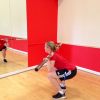
The benefits of deep squat exercises
Here are two of the best reasons why you should include deep squats into your fitness routine: build muscle and burn fat!
The humble squat might just be the most effective exercise you can do: It engages the entire lower half of the body, including the hips, glutes, quads, hamstrings, and calves, while also hitting the core, shoulders, and back. A perfect squat is a symphony of muscular co-ordination throughout the entire body, achieving the rare feat of simultaneously building muscle and burning fat thanks to its high metabolic demand. But how low should you go?
The perfect squat is a deep squat, with the hip crease going all the way past the knees. Deep squats recruit more muscles, burn more calories, and are particularly good for building strong gluteal muscles. But there’s a lot more to this exercise than one might think. It’s not just important to stretch — without a strong core, loose shoulders, an engaged back, and high mobility, the risk of injury multiplies.
Contrary to popular belief, squatting deep is not bad for the knees — studies have found there is no difference between partial, parallel, and deep squats in terms of the impact on the front knee joint. In fact, deep squats might actually increase knee stability. Most of the connective tissue in the knee is made up of two ligaments: The anterior and posterior cruciate ligament, also known as the ACL and the PCL. Studies show the forces inside the ACL and PCL decrease the more the knee is bent, meaning the deeper you squat, the less pressure there is inside the knees. It’s also a better way to get stronger. In fact, research has shown that parallel squats with heavy weights are less effective at increasing strength than deep squats with a lighter weight.Studies show the gluteus maximus is over 25 percent more engaged during deep squats than when squatting parallel.
A deep squat is a more complicated and, if performed incorrectly, riskier than the standard variation. There is an enormous number of joints and muscles that work together in a very broad range of motion to perform this movement, so extra special attention needs to be paid to mobility, flexibility, stability, and coordination. The personal trainers in the gym can help with this. Build muscle and burn fat with deep squat exercises.
If you never squat deep, it’s likely you don’t have enough control, flexibility, or strength to do so with heavy weights — yet. Take a step back, remove the weight, and study the basics first.
1. Concentrate on mobility.
“Mobility” is a word that gets thrown around a lot, but what does it mean in the context of lifting weights? Physical therapy expert Dr. Mike Reinold defines it as the body’s ability to perform a task without compensation. Ever tried a bicep curl with a weight that’s a little too heavy and found your hips and back bending and swinging? That’s the body compensating for a lack of strength. But when form goes down the drain in an attempt to lift a lot of weight, the body is at greater risk for injury. That’s especially true when it comes to squats. Reinold emphasizes the importance of flexible ankles, hip flexors, and knees.
2. Engage your muscles.
After a full body warm-up that includes dynamic stretches, it’s important to remember to engage your muscles as the squat is performed. The heavier the weight, the more important it is that the abdominals, shoulders, and upper back stay engaged, creating a stable base for the weight. Flex the thighs, squeeze your glutes, tense the stomach, and, in the case of back squats, activate the upper back by pulling down on the bar. This helps stabilize the body and keep the body from compensating by making sure that all the right muscles are doing their part.
3. Go back to basics.
There are, sadly, a lot of ways to squat badly. Even if your parallel squats can lift a lot of weight, Reinold recommends beginning your deep squatting routine using only your bodyweight, then gradually increasing the load. Starting from the beginning again, while pretty frustrating for advanced lifters, is the best way to fill any lingering gaps in your strength, stability, and form.
Some people will naturally have better mobility and stability than others. That’s why there’s no one size fits all approach to strength training, and why for some of us, deep squats aren’t on the table. Nonetheless, they’re worth aiming for: Deep squats are an incredibly valuable tool to build strength and lose body fat, and the steps we’ve outlined are holistic — better mobility, posture, strength and flexibility will benefit every aspect of your fitness.
Find out more about personal trainers, the gym and fitness classes. http://exetergcc.co.uk/gym/gym-in-exeter




















